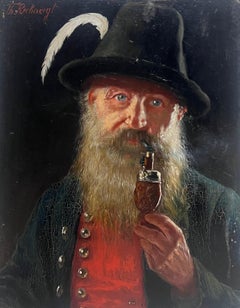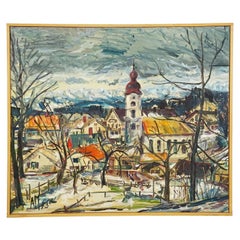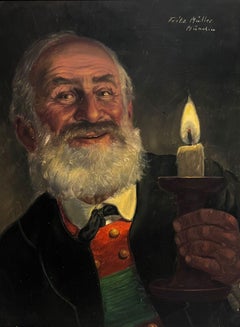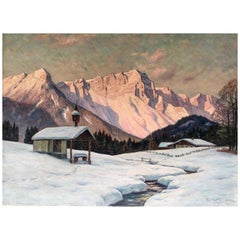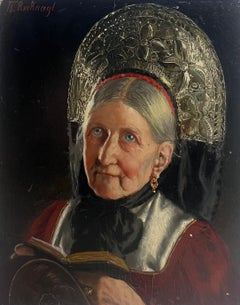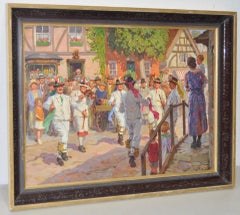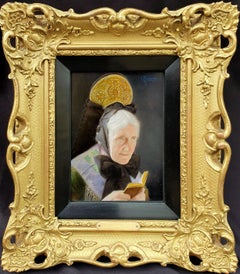Bavarian Oil Painting
to
4
17
9
17
8
7
5
3
2
2
2
1
1
1
1
1
1
1
1
2
1
1
1
Sort By
Antique German Signed Oil Painting Portrait of Bavarian Gentleman with Pipe
Located in Cirencester, Gloucestershire
Portrait of a Bavarian Gentleman with Pipe
by Theodor Recknagl (1865-1945) German
signed oil on
Category
Late 19th Century Victorian Portrait Paintings
Materials
Oil
Vintage Oil Painting of a Bavarian Village, Alexander Michael 1973
Located in Berghuelen, DE
Vintage Oil Painting of a Bavarian Village, Alexander Michael 1973
A framed oil painting depicting
Category
Vintage 1970s German Other Paintings
Materials
Canvas, Wood, Paint
$725
H 28.75 in W 32.68 in D 1.19 in
Bavarian Gentleman Holding a Candle Fine German Oil Painting Portrait of Man
By Fritz Muller
Located in Cirencester, Gloucestershire
Fritz Muller (1913 - 1972)
oil painting on board, framed
signed
framed: 17 x 14.5 inches
board: 14
Category
20th Century Realist Figurative Paintings
Materials
Oil
$1,090
H 17 in W 14.5 in
Bavarian Sonnenaufgang
By Erwin Kettemann
Located in Wiscasett, ME
Oil on canvas, signed lower right.
Erwin Kettemann (1897–1971) was a landscape painter from Munich
Category
1930s Realist Landscape Paintings
Materials
Oil
Fine Antique German Signed Oil Painting Portrait of Bavarian Lady in Head Dress
Located in Cirencester, Gloucestershire
Portrait of a Lady
by Theodor Recknagl (1865-1945) German
signed oil on board, unframed
board : 7.5
Category
Late 19th Century Victorian Portrait Paintings
Materials
Oil
William Harisch (1914-1967) - 1951 Oil, Bavarian Pipe Smoker
Located in Corsham, GB
A charming portrait study depicting a man in traditional Bavarian dress smoking a pipe. The elderly
Category
Mid-20th Century Portrait Paintings
Materials
Oil
$294 Sale Price
20% Off
H 15.75 in W 13.39 in
Bavarian Celebration Painting by WRS Stott c.1930s
Located in San Francisco, CA
Bavarian Celebration Painting by WRS Stott c.1930s
Wonderful original illustration painting by
Category
Early 20th Century Impressionist Figurative Paintings
Materials
Oil
$1,000
H 20 in W 26 in D 3 in
“Bavarian Flower Girls”
Located in Southampton, NY
Here for your consideration is a vibrant portrait of a pair of Bavarian flower girls in traditional
Category
1870s Academic Figurative Paintings
Materials
Canvas, Oil
A Bavarian Couple (Pair)
By Carl Heuser
Located in Belgravia, London, London
Oil on panel
Panel size: 6.5 x 5 inches each
Both signed upper right
Category
19th Century Portrait Paintings
Materials
Oil, Panel
Alpine School – Vintage Bavarian Landscape Painting of Watzmann, signed T. Kell
Located in Zofingen, AG
Attributed to: T. Kell (Alpine School)
Medium: Oil on canvas
Technique: Impasto painting with
Category
20th Century Impressionist Landscape Paintings
Materials
Oil
$897
H 11.03 in W 14.97 in D 0.79 in
Pair of Romantic Bavarian Paintings by Karl Adolf Wilhelm Chelius - 1889
Located in Roma, IT
Pair of romantic Bavarian paintings is an old master artwork realized in 1889 by the master Karl
Category
1880s Modern Landscape Paintings
Materials
Oil, Canvas
$17,099
H 19.69 in W 32.29 in D 0.79 in
Vintage Bavarian Lake Landscape in European Style
Located in Soquel, CA
Gorgeous vintage landscape of Bavarian lake with snow-capped mountains in background. Signed
Category
1970s Impressionist Landscape Paintings
Materials
Masonite, Oil
New Year's Eve in a provincial Bavarian town
Located in Oslo, NO
The painting depicts a short winter day before the New Year, when it is getting dark early. This is
Category
2010s Realist Landscape Paintings
Materials
Canvas, Oil
$4,280
H 21.66 in W 35.44 in D 0.79 in
R. Murdlack - 1945 Oil, Bavarian Man
Located in Corsham, GB
A charming portrait study of a Bavarian Man smoking a pipe. He wears traditional dress with a tall
Category
Mid-20th Century Portrait Paintings
Materials
Oil
Two Bavarians
By André Schulze
Located in Philadelphia, PA
This piece titled "Two Bavarians" is an original artwork made from oil on double vintage portrait
Category
21st Century and Contemporary Contemporary Portrait Paintings
Materials
Wood, Found Objects, Oil
Alfred Bentley (1879-1923) - Signed & Framed Oil, Bavarian Street Scene
Located in Corsham, GB
An impressive oil painting by English artist Alfred Bentley, depicting a Bavarian street scene. The
Category
Late 19th Century Realist Landscape Paintings
Materials
Oil
Hans Weidinger 1940s Oil Landscape Painting of Tegernsee in the Bavarian Alps
Located in Atlanta, GA
A German oil on canvas mounted on board landscape painting by artist Hans Weidinger from the Mid
Category
Mid-20th Century German Paintings
Materials
Wood, Paint, Canvas
$2,500
H 30 in W 37.5 in D 1.25 in
Large Oil on Canvas Painting Artwork by Hubert Haider Vintage Antique Bavarian
Located in Wisbech, Cambridgeshire
Large oil on canvas painting artwork by Hubert Haider 1945, vintage antique Bavarian landscape
Category
Vintage 1940s Paintings
Materials
Canvas
$1,628
H 22.05 in W 23.63 in D 1.19 in
Inge Gruber - Framed 20th Century Oil, Portrait of a Bavarian Gentleman
Located in Corsham, GB
Portrait of a Bavarian gentleman smoking a pipe. Signed lower right. Presented in a beautiful
Category
20th Century Portrait Paintings
Materials
Oil
$397
H 15.16 in W 13.19 in
H. Pfahlmer, Impressionistic Boats on the Chiemsee Near Munich, 1924
Located in Berghuelen, DE
in the bavarian alpine upland. Oil painting on canvas with vigorous pastell colors. Painted by Hugo
Category
Early 20th Century German Paintings
Materials
Canvas
$2,280
H 24.41 in W 31.11 in D 3.55 in
Bavarian Spring Landscape
Located in Soquel, CA
Beautiful mid-century autumn landscape with a calm body of water near Munchen (Munich) by Karl Gatermann the Younger (Germany, 1909-1992). Signed and titled "Munchen" lower left cor...
Category
1950s Impressionist Landscape Paintings
Materials
Canvas, Oil
An Old Bavarian Gentleman
By Carl Heuser
Located in Nr Broadway, Worcestershire
Carl Heuser
German, (1827-1892)
An Old Bavarian Gentleman
Oil on panel, signed
Provenance
Category
19th Century Victorian Portrait Paintings
Materials
Oil, Wood Panel
Oversized German Bavarian Landscape 1960
Located in Douglas Manor, NY
3964 Oil on canvas of the Bavarian landscape
Set in a carved gilt wood frame
Category
1960s Landscape Paintings
Materials
Oil
Alois Pfund (1876-1946) - Early 20th Century Oil, Mittenwald, Bavarian Alps
Located in Corsham, GB
A wonderful, expressive study of the Bavarian Alps by the well known artist Alois Pfund. Here the
Category
20th Century Landscape Paintings
Materials
Oil
$726
H 14.18 in W 11.03 in
'Portrait of a Young Bavarian Woman' Alpine Figural Landscape oil, Munich School
By Emil Rau
Located in Santa Cruz, CA
, jewel-like study of a young Bavarian girl, wearing an embroidered blouse, lilac sash and green felt hat
Category
1910s Academic Portrait Paintings
Materials
Canvas, Oil
Emil Rau'Portrait of a Young Bavarian Woman' Alpine Figural Landscape oil, Munich School, Circa 1915
$6,500
H 17.75 in W 13.75 in D 0.75 in
Friedrich Lettau, Bavarian Folksy Man with Beer Mug, Oil on Wood Ca. 1950s
Located in Berghuelen, DE
Friedrich Lettau - Bavarian folksy man with beer mug, oil on wood ca. 1950s
An colorful oil
Category
Mid-20th Century German Biedermeier Paintings
Materials
Wood
$765
H 15.75 in W 13.78 in D 1.25 in
Get Updated with New Arrivals
Save "Bavarian Oil Painting", and we’ll notify you when there are new listings in this category.
Bavarian Oil Painting For Sale on 1stDibs
Surely you’ll find the exact bavarian oil painting you’re seeking on 1stDibs — we’ve got a vast assortment for sale. You can easily find an example made in the contemporary style, while we also have 8 contemporary versions to choose from as well. If you’re looking for a bavarian oil painting from a specific time period, our collection is diverse and broad-ranging, and you’ll find at least one that dates back to the 18th Century while another version may have been produced as recently as the 21st Century. On 1stDibs, the right bavarian oil painting is waiting for you and the choices span a range of colors that includes brown, black, gray and blue. There have been many interesting bavarian oil painting examples over the years, but those made by Charles Henry Miller, Fritz Muller, Hermine Gartner, Carl Heuser and Edward Cucuel are often thought to be among the most thought-provoking. Artworks like these of any era or style can make for thoughtful decor in any space, but a selection from our variety of those made in paint, oil paint and fabric can add an especially memorable touch.
How Much is a Bavarian Oil Painting?
The price for a bavarian oil painting in our collection starts at $345 and tops out at $265,000 with the average selling for $3,074.
Questions About Bavarian Oil Painting
- 1stDibs ExpertMarch 22, 2024To maintain oil paintings that you purchased for your home, experts suggest that you keep them out of direct sunlight. Prolonged exposure to the sunlight coming in from a window can fade the colors in your painting. Do not hang your oil painting near a heat source or where it can get wet (bathrooms and kitchens are not safe for your oil painting).
You may wish to dust your oil painting so that layers of dust don’t begin to gather on its surface. This should only be considered to remove loose dust. Never spray any chemical substance on your oil painting. Do not use a damp cloth to dust your oil painting. (Again, your painting should not be exposed to moisture.)
To remove loose dust, use a soft brush that measures approximately one to two inches wide with natural-hair bristles. Do not use a dust cloth or a feather duster, as those items may catch or leave threads or feathers behind. Do not apply pressure or dust your painting for an extended period of time.
If you think that your oil painting is considerably dirty or believe that other issues may be at work, experts strongly suggest that you consult with a professional conservator.
Read about how to arrange your wall art and find oil paintings for sale on 1stDibs. - What is abstract oil painting?1 AnswerLilac Gallery Ltd.March 17, 2021An abstract oil painting and an artwork that is made with oil paint on a medium like canvas, wood board, or other panels like canvas board. And the 'abstract' term refers to the Movement & Style of the piece. As abstraction indicates a departure from reality in the depiction of imagery in art, the artist creates a painting where the subject, shape, form, color, and line, is created with no particular references of the world but as a composition that may exist with a degree of independence from its vision.
- 1stDibs ExpertFebruary 13, 2024To identify an oil painting, look closely at its surface. Compared to other paintings, pieces produced in oils usually show off a variety of textures across the canvas, and the paint will appear layered on. If you're looking to determine the name, age or creator of a work, try snapping a photo with your smartphone’s camera and conducting a reverse image search online. Shop a diverse assortment of oil paintings on 1stDibs.
- 1stDibs ExpertMay 3, 2024Jan van Eyck is widely considered by art historians to be the father of oil painting. While the usage of oil paints dates back to 7th-century China, the Flemish painter popularized the material, using oils to produce highly detailed works such as The Arnolfini Portrait. The Northern Renaissance master also influenced many other artists, such as Hugo van der Goes and Gerard David. Shop an assortment of fine art on 1stDibs.
- When was oil paint invented?1 Answer1stDibs ExpertFebruary 27, 2024Oil paint was invented during the 7th century A.D. The earliest examples of oil paintings have been traced to Afghanistan and depict scenes related to the Buddhist religion. Records dating back to the 12th century indicate that early Christian monks in Europe used oil paints to decorate furniture, and a century later, some artists began finishing tempera paintings with touches of oil paint. It wasn't until the 15th century that oil paints became a common medium for European painters, when Flemish artists like Jan van Eyck began favoring them over tempera. Explore a variety of oil paintings on 1stDibs.
- 1stDibs ExpertAugust 20, 2024The difference between a lithograph and an oil painting comes down to uniqueness and technique. To produce an oil painting, an artist applies oil-based paints to a canvas or another surface using a brush. The process results in a single work of art. Lithography is a form of printmaking that begins by drawing on or painting on a stone surface with an oil-based substance, such as a greasy crayon or tusche, an oily wash. The stone is then covered with water, which is repelled by the oily areas. Oil-based ink is then applied to the wet stone, adhering only to the oily image. Through lithography, an artist can produce dozens, or even thousands, of copies of a single image. On 1stDibs, shop a large selection of lithographs and oil paintings.
- 1stDibs ExpertMay 3, 2024A few things make an oil painting valuable. Age has a major impact on price, with pieces made over a century ago tending to fetch the highest prices. Who created the painting also matters. The more famous the artist, the higher the selling price for a painting is likely to be. Finally, the condition of the work and whether it is in its original frame will also impact how much it is worth. Find a diverse assortment of oil paintings on 1stDibs.
- How much do oil paintings cost?1 Answer1stDibs ExpertSeptember 25, 2019
On 1stdibs, oil paintings cost between $60 and $6,200,000.
- 1stDibs ExpertMarch 22, 2024Yes, oil paintings darken over time. As oil paint is made of pigment particles, the range of substances that are used as pigment in oil paint can render certain colors susceptible to aging. Slowing the aging process for an oil painting involves storing your painting properly and keeping the work out of exposed sunlight. Temperature control and humidity are also important in preserving the life of an oil painting and slowing the aging process.
To maintain oil paintings that you purchased for your home, experts suggest that you keep them out of direct sunlight. Prolonged exposure to the sunlight coming in from a window can fade the colors in your painting. Do not hang your oil painting near a heat source or where it can get wet (bathrooms and kitchens are not safe for your oil painting).
You may wish to dust your oil painting so that layers of dust don’t begin to gather on its surface. This should only be considered to remove loose dust. Never spray any chemical substance on your oil painting. Do not use a damp cloth to dust your oil painting. (Again, your painting should not be exposed to moisture.)
To remove loose dust, use a soft brush that measures approximately one to two inches wide with natural-hair bristles. Do not use a dust cloth or a feather duster, as those items may catch or leave threads or feathers behind. Do not apply pressure or dust your painting for an extended period of time.
If you think that your oil painting is considerably dirty or believe that other issues may be at work, experts strongly suggest that you consult with a professional conservator.
Read about how to arrange your wall art and find oil paintings for sale on 1stDibs. - 1stDibs ExpertApril 5, 2022To tell if your oil painting is authentic, first check the signature of the artist to start your research. Use a magnifying glass to check the texture of the painting, and finally check the back for the painting’s original stretchers. Shop a selection of expertly vetted artwork from some of the world’s top art dealers on 1stDibs.
- 1stDibs ExpertFebruary 13, 2023Because the value of an oil painting can vary greatly based on the artist, the subject and the condition of the piece, it's generally best to work with a certified appraiser. A knowledgeable professional can evaluate the piece and estimate its value. Shop a variety of authentic oil paintings from some of the world’s top galleries on 1stDibs.
- La ChrysomeleFebruary 24, 2021Any artwork is worth and only worth the price someone is willing to pay for it (unfortunately, whether one can afford it or not is another story). Different people may have different reasons to attribute value to an artwork, from the purest (falling in love with it) to what is often considered as the most vile (speculation), going through remembrance, pride of ownership, or brag, among other reasons. For most living artists, the price of the artworks is usually set by the artist and/or the gallery which represent him or her, by type and size of artwork, and corresponds to an equilibrium price between the rate at which artworks are sold and the rate at which new artworks are produced by the artist. For artworks from dead artists sold by professional dealers, the price is often based on auctions results for similar pieces of the same artists. Oil paintings are usually pricier than other techniques because it is considered more difficult to master, but also because oil paintings are known for their ability to last centuries.
- 1stDibs ExpertApril 5, 2022The best place to find oil paintings and discover new artists is at local art galleries. There are also many online art dealers who provide information about artists and sell their works. On 1stDibs, you’ll discover a variety of art styles from master oil painters.
- 1stDibs ExpertApril 5, 2022To find the artist of an oil painting, look on the back of the canvas. Sometimes, you will find the artist’s name and the year of production on the back. If the canvas is in a frame, gently peel away the paper covering the back to access the canvas. In the event you cannot find any identifying information, seek the help of a licensed art appraiser. Shop a selection of oil paintings on 1stDibs.
- 1stDibs ExpertMarch 22, 2024Yes, sunlight affects oil paintings. Keep your oil paintings away from direct sunlight.
To maintain oil paintings that you purchased for your home, experts suggest that you keep them out of sunlight. Prolonged exposure to the sunlight coming in from a window can fade the colors in your painting. Do not hang your oil painting near a heat source or where it can get wet (bathrooms and kitchens are not safe for your oil painting).
You may wish to dust your oil painting so that layers of dust don’t begin to gather on its surface. This should only be considered to remove loose dust. Never spray any chemical substance on your oil painting. Do not use a damp cloth to dust your oil painting. (Again, your painting should not be exposed to moisture.)
To remove loose dust, use a soft brush that measures approximately one to two inches wide with natural-hair bristles. Do not use a dust cloth or a feather duster, as those items may catch or leave threads or feathers behind. Do not apply pressure or dust your painting for an extended period of time.
If you think that your oil painting is considerably dirty or believe that other issues may be at work, experts strongly suggest that you consult with a professional conservator.
Read about how to arrange your wall art and find oil paintings for sale on 1stDibs. - Can you use oil paint on wood?1 Answer1stDibs ExpertFebruary 22, 2021You can use oil paint on wood as long as you prep the wood first. The first thing you should do is seal the wood with a primer. Ideally, paint two coats of sealer onto the wood so that the paint doesn't cause the wood to rot over time.
- Did Dali use oil paint?1 Answer1stDibs ExpertApril 5, 2022Yes, Dali did indeed use oil paint. Although he used oil paints in the traditional method, he would at times add natural resin or linseed oil to play with fluidity and texture. You can shop a selection of Salvador Dali’s pieces from some of the world’s top art dealers on 1stDibs.
- 1stDibs ExpertAugust 15, 2024To tell how old an oil painting is, research the artist who produced it. You can use the mobile app Smartify to snap a photo of the signature on your painting and identify the artist. Read biographical information about the artist online and look at images of their work to estimate the age of your piece. Alternatively, you can get the opinion of a knowledgeable art dealer or certified appraiser. Explore a wide variety of oil paintings on 1stDibs.
- 1stDibs ExpertApril 5, 2022The largest oil painting in the world is in the main hall of the Doge's Palace located in Venice, Italy. Its name is Il Paradiso. Tintoretto painted it around 1592, and it measures 22 meters by 7 meters. Shop a large collection of oil paintings on 1stDibs.
- 1stDibs ExpertSeptember 25, 2019
Varnishing an oil is not necessary, but it is recommended because it protects the painting and corrects surface irregularities.
More Ways To Browse
Rose Cut Oval Engagement Ring
Paraiba Gold Ring
Green Paraiba Rings
African Gold Ring
Oval Paraiba Ring
Tourmaline Ring Purple
Flawless Sapphire Ring
Paraiba Tourmaline Pear
Pear Green Tourmaline Ring
Vintage Smokers
White Spinel Engagement Ring
14k Green Spinel Rings
Bavarian Glass
Unheated Madagascar Sapphire
Intaglio Pendant
White Sequin Top
German Sheep
Victorian Antlers
